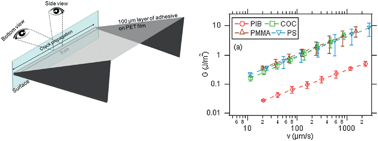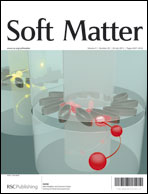The motion of the triple line during the debonding of a soft viscoelastic adhesive from a rigid polymer surface has been investigated quantitatively. In order to make the debonding geometry simpler than the probe tack test, a new technique, called the sticky wedge test, has been developed where the probe is constituted by a horizontal cylinder instead of a flat punch. The crack propagates in the elongated contact area between the cylinder and the flat surface, thereby, allowing us to measure optically in situ the crack-tip velocity and the receding contact angle of the debonding adhesive. Two model pressure sensitive adhesives (PSA) based on poly(n-butyl acrylate-co-acrylic acid) with different molecular weights and branching levels and four polymer substrates (rubbery or glassy at room temperature) were used. Due to the soft and incompressible nature of the adhesive, the strain energy release rate for this test geometry has been estimated by the equations for the pure shear test geometry. The results show three main new insights: first, despite significant approximations, this novel approach holds promise to characterize more quantitatively the interfacial crack propagation between soft viscoelastic solids and hard surfaces and the relationship between the applied energy release rate  and the crack-tip velocity v has been reliably established for eight combinations of the model viscoelastic adhesives and surfaces. Second, at equivalent values of the thermodynamic work of adhesion, the adhesion energy of both the adhesives against the rubbery surface was much lower than that against the glassy polymers. Third, surprisingly, the measured receding contact angle of debonding was close to 90° for all adhesive/surface combinations used.
and the crack-tip velocity v has been reliably established for eight combinations of the model viscoelastic adhesives and surfaces. Second, at equivalent values of the thermodynamic work of adhesion, the adhesion energy of both the adhesives against the rubbery surface was much lower than that against the glassy polymers. Third, surprisingly, the measured receding contact angle of debonding was close to 90° for all adhesive/surface combinations used.

You have access to this article
 Please wait while we load your content...
Something went wrong. Try again?
Please wait while we load your content...
Something went wrong. Try again?
 and the crack-tip velocity v has been reliably established for eight combinations of the model viscoelastic adhesives and surfaces. Second, at equivalent values of the thermodynamic work of adhesion, the adhesion energy of both the adhesives against the rubbery surface was much lower than that against the glassy
and the crack-tip velocity v has been reliably established for eight combinations of the model viscoelastic adhesives and surfaces. Second, at equivalent values of the thermodynamic work of adhesion, the adhesion energy of both the adhesives against the rubbery surface was much lower than that against the glassy 

 Please wait while we load your content...
Please wait while we load your content...